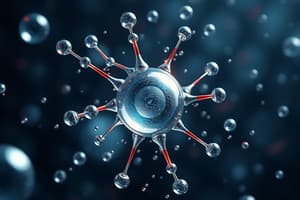Podcast
Questions and Answers
What distinguishes an element from a molecule?
What distinguishes an element from a molecule?
- Molecules are simpler than elements.
- A molecule is made of two or more atoms. (correct)
- An element is composed of molecules.
- Elements cannot exist on their own.
What does the atomic number of an element represent?
What does the atomic number of an element represent?
- The total mass of all the subatomic particles.
- The number of electrons plus neutrons.
- The number of protons in the atom. (correct)
- The total number of neutrons in the atom.
Which of the following correctly represents a diatomic molecule?
Which of the following correctly represents a diatomic molecule?
- Carbon (C)
- Helium (He)
- Gold (Au)
- Oxygen gas (O2) (correct)
Which characteristic is NOT typical of metals?
Which characteristic is NOT typical of metals?
What is the maximum number of elements in the first period of the periodic table?
What is the maximum number of elements in the first period of the periodic table?
Which term describes an atom that has lost or gained one or more electrons?
Which term describes an atom that has lost or gained one or more electrons?
Which of these elements is considered a non-metal?
Which of these elements is considered a non-metal?
What does the periodic table organize elements by?
What does the periodic table organize elements by?
Flashcards
Atom
Atom
The smallest particle of matter, which cannot be created, destroyed, or broken down further.
Element
Element
A pure substance made of only one type of atom.
Monatomic
Monatomic
Consisting of a single atom.
Diatomic
Diatomic
Signup and view all the flashcards
Periodic Table
Periodic Table
Signup and view all the flashcards
Atomic Number
Atomic Number
Signup and view all the flashcards
Mass Number
Mass Number
Signup and view all the flashcards
Metals
Metals
Signup and view all the flashcards
Non-metals
Non-metals
Signup and view all the flashcards
Study Notes
Atoms and Elements
- Atoms are the smallest particles of matter. They cannot be created, destroyed, or broken down further.
- Elements are pure substances made of only one type of atom.
- There are around 90 naturally occurring elements and approximately 20 artificially created ones.
- Elements are arranged in the periodic table based on the size of their atoms.
Success Criteria
- Define the terms element, monatomic, diatomic, and periodic table.
- Describe the key features of the periodic table, including periods and groups.
- List the first 20 elements of the periodic table and their symbols.
- Relate the atomic number and mass number of an element to the number of subatomic particles.
Parts of an Atom
- Proton: A subatomic particle with a positive electrical charge.
- Neutron: A subatomic particle with no electrical charge.
- Electron: A subatomic particle with a negative electrical charge.
- The nucleus contains protons and neutrons.
- Electrons orbit the nucleus.
Molecules
- A molecule is a group of two or more atoms bonded together.
Monoatomic vs. Diatomic
- Monoatomic: Consisting of a single atom.
- Diatomic: A molecule made from two atoms.
Periodic Table
- The periodic table arranges elements by atomic size.
- Elements are represented by their symbols.
- Groups and periods are used to categorize elements.
- Non-metals are mostly gases at room temperature and poor conductors of heat and electricity. Metals are generally solids at room temperature and good conductors.
Properties of Metals and Non-metals
- Metals: Usually solids at room temperature, good conductors of heat and electricity, ductile (can be drawn into wires), malleable (can be hammered into sheets), and generally shiny.
- Non-metals: Mostly gases or brittle solids at room temperature, poor conductors of heat and electricity, and generally dull.
First 20 Elements
- Students should memorize the first 20 elements and their symbols. (A YouTube video link for further help was provided)
Studying That Suits You
Use AI to generate personalized quizzes and flashcards to suit your learning preferences.




